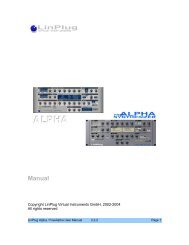CronoX 2 User Guide 1.02.sdw - LinPlug Virtual Instruments
CronoX 2 User Guide 1.02.sdw - LinPlug Virtual Instruments
CronoX 2 User Guide 1.02.sdw - LinPlug Virtual Instruments
Create successful ePaper yourself
Turn your PDF publications into a flip-book with our unique Google optimized e-Paper software.
Dual LFO<br />
An LFO is an oscillator that generates low frequency control signals that can be<br />
used to modulate other aspects of the audio signal. The <strong>CronoX</strong> contains 2<br />
separate LFOs each offering 5 user parameters. These are: Wave, Sync, Freq<br />
(Frequency), Attack and Sym (Symmetry). Both LFOs are identical.<br />
To select one of the LFOs waveforms click on one of the waveform buttons at the<br />
bottom left of the LFO section. Six LFO waveforms are available: Sine, Triangle,<br />
Ramp, Square, Noise and Sample and Hold.<br />
The Sync menu enables you to sync LFO triggering with the current tempo (see<br />
Appendix D for the range of possible sync settings). It should be noted that when<br />
the Noise and Sample and Hold waveforms are synced to tempo, they run at a<br />
faster tempo than the other LFO waveforms. For example, if you set sync to 1/1,<br />
use a tempo of 120 bpm and play a whole note (4 beats), the duration of one<br />
cycle of the regular waveforms (Sine, Triangle, Ramp, Square) will be 2 seconds.<br />
However, the Sample and Hold and Noise waveforms will change their state<br />
within 1/8 of 2 seconds or 0.25 seconds. Also, don't forget that when the LFO is<br />
synced to tempo, the Freq (Frequency) control no longer operates.<br />
The "Freq" (Frequency) parameter determines the LFO's frequency (in Hz).<br />
Range: 0.04 Hz...32 Hz.<br />
<strong>LinPlug</strong> <strong>CronoX</strong> <strong>User</strong> <strong>Guide</strong> 1.02 26












